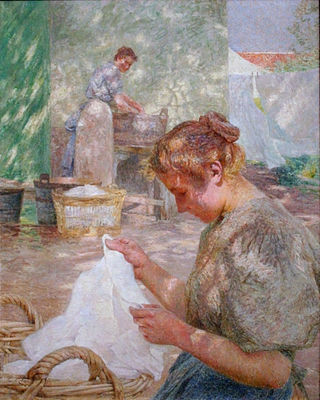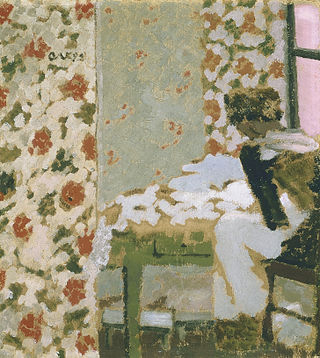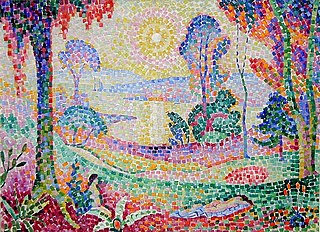
Pointillism is a technique of painting in which small, distinct dots of color are applied in patterns to form an image.

Johannes Theodorus "Jan" Toorop was a Dutch painter who worked in various styles, including Symbolism, Art Nouveau, and Pointillism. His early work was influenced by the Amsterdam Impressionism movement.

Henri-Edmond Cross, born Henri-Edmond-Joseph Delacroix, was a French painter and printmaker. He is most acclaimed as a master of Neo-Impressionism and he played an important role in shaping the second phase of that movement. He was a significant influence on Henri Matisse and many other artists. His work was instrumental in the development of Fauvism.

Maximilien Luce was a prolific French Neo-impressionist artist, known for his paintings, graphic art, and his anarchist activism. Starting as a wood-engraver, he then concentrated on painting, first as an Impressionist, then as a Pointillist, and finally returning to Impressionism.

Neo-Impressionism is a term coined by French art critic Félix Fénéon in 1886 to describe an art movement founded by Georges Seurat. Seurat's most renowned masterpiece, A Sunday Afternoon on the Island of La Grande Jatte, marked the beginning of this movement when it first made its appearance at an exhibition of the Société des Artistes Indépendants in Paris. Around this time, the peak of France's modern era emerged and many painters were in search of new methods. Followers of Neo-Impressionism, in particular, were drawn to modern urban scenes as well as landscapes and seashores. Science-based interpretation of lines and colors influenced Neo-Impressionists' characterization of their own contemporary art. The Pointillist and Divisionist techniques are often mentioned in this context, because they were the dominant techniques in the beginning of the Neo-Impressionist movement.

Albert Dubois-Pillet was a French Neo-impressionist painter and a career army officer. He was instrumental in the founding of the Société des Artistes Indépendants, and was one of the first artists to embrace Pointillism.

Théophile "Théo" van Rysselberghe was a Belgian neo-impressionist painter, who played a pivotal role in the European art scene at the turn of the twentieth century.

Luminism is a late-impressionist or neo-impressionist style in painting which devotes great attention to light effects.

The Two Sisters, also known as The Serruys Sisters is an 1894 oil painting by Belgian artist Georges Lemmen, located in the Indianapolis Museum of Art, which is in Indianapolis, Indiana. It uses pointillism to depict the sisters Jenny and Berthe Serruys.

The Seamstress is an 1893 oil painting by French artist Édouard Vuillard, located in the Indianapolis Museum of Art, which is in Indianapolis, Indiana. It is a small, intimate image of a woman sewing.

The Channel of Gravelines, Petit Fort Philippe is a pointillist painting by French artist Georges Seurat, located in the Indianapolis Museum of Art in Indianapolis, Indiana. Painted in 1890, the year before his death, it depicts a harbor in the small French port of Gravelines. Described as "wistful and poetic," it is one of the treasures of the IMA.

The House of the Deaf Woman and the Belfry at Eragny is an 1886 oil painting by French artist Camille Pissarro, located in the Indianapolis Museum of Art, which is in Indianapolis, Indiana. It is a view of Pissarro's neighbor's yard in Eragny, created during his brief period of experimentation with pointillism.

The Banks of the Oise near Pontoise is an 1873 oil painting by French artist Camille Pissarro, located in the Indianapolis Museum of Art, which is in Indianapolis, Indiana. It depicts the river Oise near the market town of Pontoise.

The Lagoon of Saint Mark, Venice is an oil on canvas painting by Paul Signac. This painting focuses on a seascape image which became a common theme late in Signac's life.

Baigneuses: Deux nus dans un paysage exotique is an oil painting created circa 1905 by the French artist and theorist Jean Metzinger (1883–1956). Two Nudes in an Exotic Landscape is a Proto-Cubist work executed in a highly personal Divisionist style during the height of the Fauve period. The painting is part of Carmen Cervera's art collection and its exhibited in the Thyssen-Bornemisza Museum, Madrid

Coucher de soleil no. 1 is an oil painting created circa 1906 by the French artist and theorist Jean Metzinger (1883–1956). Coucher de soleil no. 1 is a work executed in a mosaic-like Divisionist style with a Fauve palette. The reverberating image of the Sun in Metzinger's painting is an homage to the decomposition of spectral light at the core of Neo-Impressionist color theory.

Afternoon Tea is a 1910 oil painting by American artist Richard E. Miller, located in the Indianapolis Museum of Art. Like many of Miller's paintings, it depicts women in a sunny scene, filled with flowers, depicted in his Impressionist style with a distinct flavor of Japonism.

Le Chahut is a Neo-Impressionist painting by Georges Seurat, dated 1889–90. It was first exhibited at the 1890 Salon de la Société des Artistes Indépendants in Paris. Chahut became a target of art critics, and was widely discussed among Symbolist critics.

Maria Sèthe at the Harmonium is an oil-on-canvas painting by the Belgian neo-impressionist painter Théo van Rysselberghe. It depicts a woman with blonde, worn-up hair and a purple dress, seen in profile gazing toward the left. The sitter was Maria Sèthe, who belonged to an affluent musical family with an interest in the arts. In the painting, she is seated at a harmonium but is not playing it.

Sailboats and Estuary is an oil-on-canvas painting by Belgian srtist Théo van Rysselberghe. Painted around 1887, it shows a coastal landscape elaborated in a Pointillist technique. Van Rysselberghe probably adopted the Pointillist manner after befriending Signac; however, the use of color in Sailboats and Esuary is nonetheless far more realistic than in paintings by Signac and other Neo-Impressionists, and reveals a tendency towards naturalism. The artwork has been in the collection of the Musée d'Orsay in Paris since 1982, on loan from the Louvre.




















